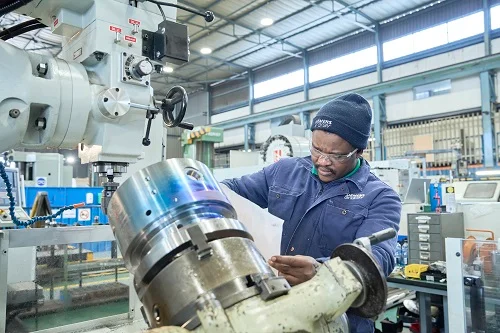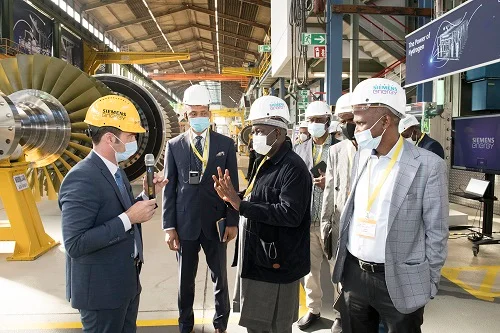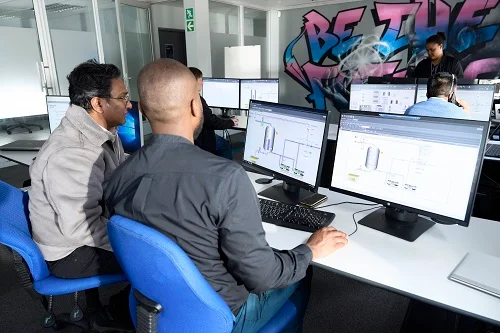Dietmar Siersdorfer, managing director of Siemens Energy Middle East & Africa, considers electrification, the need for natural gas, the focus on transmission and emerging digital solutions within Africa’s energy landscape
At the recently concluded Africa Energy Forum (aef) in Barcelona, Siersdorfer, opened a session exploring the continent’s energy landscape and how its resources are poised to take a central position in the global energy revolution.
In his address to the delegates, Siersdorfer’s excitement for his new role as leader of Siemens Energy in Africa was palpable, pointing out that the continent is the fastest growing energy market on the globe – forecast by the organisation to grow by 15% CAGR between 2023 and 2028 alone – and has a number of competitive advantages playing in its favour. The latter, Siersdorfer listed, including the abundant renewable resources available to African nations; a strategic geographical position that could enable it to become an exporter of electrons for neighbouring regions; the potential it holds for innovation (describing it as a “laboratory” where future technologies could be matured); and its accelerating energy demand (expected to surge by 60% between 2022 and 2030, according to the IEA). Moreover, the whole continent is responsible for a mere 1.4 giga tons of energy-related emissions per year, an astonishingly small contribution, even when compared to select single countries (China produces 10.8 giga tons per year).
To lay the groundwork for Africa to achieve its potential, Siersdorfer identified four points that he believed must be focused on: maintaining reliable power supply, making energy greener, embracing system complexity, and adopting digital solutions. To dig into these further, African Review spoke to the managing director at the conference in Barcelona.
Going green via gas
While Siersdorfer noted that the 1.5-degree threshold is probably out of our grasp now, he stressed we must still strive to limit global warming and ultimately achieve net zero. In this pursuit, the imperative of integrating green generation capacity within Africa (and the global) energy landscape is, in the modern day, well understood.
However, the managing director was quick to emphasise that with Africa responsible for such a minor proportion of global emissions, the need to minimise its environmental impact must be balanced against the dire need for providing reliable energy access to the vast population of African inhabitants who currently live without it.
For Siersdorfer, the way to steer this course is clear, and it resides in a resource categorised as a fossil fuel: natural gas. This definition, the managing director explained, has somewhat cooled global appetites of late, with some commentators suggesting a hard break from hydrocarbons is the path Africa should take. In the view of Siersdorfer, though, it is the right of less developed nations to exploit their natural resources in order to close the development gap – as many advanced countries have done before. As a reliable, plentiful, valuable and affordable energy source that has a far smaller climate footprint than its fossil fuel cousins, gas presents the perfect bridge in the transition to net zero, he surmised. Moreover, it is widely viewed as the frontrunner to hydrogen, with associated technology and infrastructure ready to adapt to a green hydrogen future should it be realised.
“Generally, Africa is embracing renewable technology but we should not underestimate that energy demand in Africa is huge (and growing),” commented Siersdorfer. “Many countries have gas available and it is therefore vital to take this resource into the equation when building sustainable energy systems. Currently, much of the continent is coal-dependent. About 70-80% of power generation in South Africa, for example, is provided by coal-fired power stations. If it was to switch immediately to gas, we predict the country would reduce CO2 emissions by 40%. Comprehensive utilisation of this resource would, therefore, massively limit emissions, form the foundation of energy systems that give people access to electricity, and build the base of industrial development.”
At this point, Siersdorfer retrieved an anecdote drawn from his extensive experience working within the Middle Eastern market. This region, despite being generally more developed than Africa, has not sought to jump straight to renewables but is, instead, choosing a path to net zero that is paved with gas-fired power stations. Perhaps the best demonstration of this policy can be seen in the US$1.5bn contract Siemens Energy has just signed in Saudi Arabia. This agreement will see the company supply key technologies for the forthcoming Taiba 2 and Qassim 2 combined-cycle power plants that will generate approximate 2GW of electricity each. Expected to be connected to the grid – in simple cycle mode – as early as 2026, they demonstrate the ability of such stations to provide rapid energy to meet growing demand while are also being a vital step in the country’s strategy to reach net zero by 2060.
This is a lesson Siersdorfer hopes African leaders will take on board as they continue to chart their own courses in the energy transition. “I would emphasise, here that it is no one size fits all of course – it is not all about renewables or gas. Country policymakers need to build transition maps that work for them, built on the resources available to them and that can be best used. This is one area Siemens Energy can help. We build country strategies and advise how to deliver energy systems of the future – specific to that environment – which encapsulate decarbonisation agendas.”
Grid modernisation
The emergence of renewables and the proliferation of energy sources will, almost certainly, lead to the growth of system complexity – a problem that proponents of a green future in Africa are striving to solve.
Indeed, grid infrastructure and the debate around transmission took centre stage at the conference in Barcelona, with delegates recognising that a traditional focus on power generation has left this aspect neglected and the need pressing. According to the IEA’s Financing Clean Energy in Africa, annual investment in grids here grew at only 5% between 2019 and 2022, with reliable and robust electricity grids remaining a missing piece of the puzzle. In the Sustainable Africa Scenario, grid investments must rise to US$50bn per year by 2030 ‘in order to finance the required expansion and modernisation of grids that the influx of renewables requires’.
“Fortunately, this is no longer a non-topic in Africa, although some ministers I speak to are still very much focused on generation,” Siersdorfer remarked. “The bottom line is: grids need more resilience in the future and they need to be more interconnected. They are the foundation of the new energy systems that need to be built for individual countries, especially for when they are looking to exchange electricity with their neighbours.”
Elsewhere, this message has been firmly understood, he explained, as countries such as Saudi Arabia are identifying the work they need to do and are now heavily investing. In doing so, they are sucking capacity from manufacturers of associated equipment and developers so that these services are becoming less available for use elsewhere.
“As a manufacturer, we are upgrading our capacities everywhere in the world as we foresee an enormous growth in the grid market across the globe,” said Siersdorfer. In Nigeria, this has translated into action with the company working with the Federal Government in support of the Presidential Power Initiative. A drive dedicated to upgrading the country’s electricity network, it is aimed at providing power to Nigerians by bringing an additional 25GW of electricity online and to upgrade and expand the national grid to connect and boost supply.
Dealing with data demand
This discussion around grid stability and reliable supply led Siersdorfer onto a topic that has dominated headlines in the recent past – the rise of the data centre market. Fuelled by an increase in connections for households and businesses alike, an increasingly urbanised and youthful population demanding access to the Internet through 3G, 4G and even 5G, and the surge of smartphone adoption, mobile data consumption in Africa is expected to increase by 40% each year until 2025, according to AIIM. To meet the exponential increase in data traffic, the continent’s digital infrastructure must be developed and an increase in capacity to 1,200MW by 2030 is required. To realise this and support the emerging digital economy, a surge in investment has been forthcoming, reaching US$2bn in 2020 and expected to reach US$5bn by 2026.
“Data centre operators need facilities up and running quickly, and they have the money to spend to do so,” Siersdorfer explained. “But, they need reliable power and a stable grid. Why, then, would they look to do develop a project in Togo or Tanzania – which could take seven years – when it could take three elsewhere and be more viable with greater energy security?
“The data centre market is a huge opportunity. If African nations are able to build resilient grids, backed by a mix of renewables and gas, then they could attract the likes of Amazon and Microsoft. If countries are willing to put in the work and invest in their grids, they can attract even greater attention from hyperscalers who can come and build business here.”
From Siemens Energy’s perspective, Siersdorfer was quick to add that the company has the equipment and expertise to provide everything a data centre requires throughout its life cycle – from integration solutions to bring power from the transmission grid to reliable and sustainable emergency backup power when energy is not available.
A clean slate for innovation
In building the energy infrastructure of the future, the managing director was also keen to point out that innovative, digital solutions could play a leading role in dealing with the complexity of their potential makeups.
As the company has made clear, optimising performance and maximising efficiency in today’s energy landscape is critical, and harnessing the power of digitalisation is crucial to do so. Data-driven control systems, advanced software and integration of artificial intelligence has the potential to enhance grid management and precision in predictability to improve load forecasting and more effectively balance supply and demand. While there is some apprehension around the emergence of AI within the energy sphere, none stems from Siersdorfer. “There is no need to fear it; there is a need to embrace it. AI it is still in its infancy but is starting to be used in many of our systems, I believe it will have a huge role in the future. More regulation around it is certainly required but when I look at our domain and the enormous potential it offers; it is a breath-taking opportunity.”
And this opportunity is not one exclusive of Africa. “The continent is in an interesting position where it can almost start afresh, right from the beginning. I see it is a laboratory for how we can conduct the energy transition from scattered systems into new, modern ones. AI will be at the forefront of this. In my mind, it is a unique and compelling chance for the African market and it will definitely be utilised in solutions that companies like Siemens Energy are providing.”
Certainly, Siemens Energy has positioned itself at the front of this technological development wave, and Siersdorfer pointed to the four innovation centres and huge R&D programme dedicated to interacting with customers, governments and beyond, and designing new solutions around their needs. This, the managing director concluded, is integral to the company’s core mission. “People ask me what our mission is. My answer is the same here as it is of any region: to energise society. I think this is a noble goal.”
This article was sponsored by Siemens Energy.






